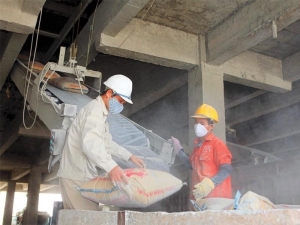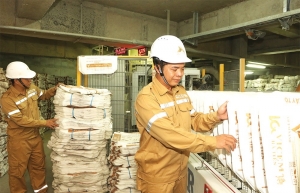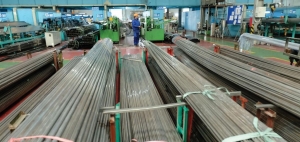The Philippines assists in reducing hurdles for Vietnam's cement exports
 |
| The signing of a commercial partnership agreement between VICEM and firms from the Philippines. Photo: Ministry of Construction |
The signing ceremony took place during National Assembly Chairman Vuong Dinh Hue's official visit to the Republic of the Philippines from November 23 to 25.
Vietnam Cement Industry Corporation (VICEM) and two importers, Fenix Company INT'L INC. and Golden Falcon Trading Corporation are participating in the signing ceremony. The parties agreed to work together to import and export 6 million metric tonnes of VICEM cement and clinker to the Philippines over a 3-year period from 2023 to 2025.
There is a tremendous need for building materials, especially cement, since the Philippine government has been pushing socioeconomic growth via infrastructure projects for the last 2 years. The signing ceremony affords Vietnamese construction material firms the chance to access the Philippine market for the export of building supplies.
Speaking about Vietnam's cement market, Vietnam National Cement Association (VNCA) president Nguyen Quang Cung said, "Domestic consumption over the last 3-4 years has averaged about 60 million tons per year, but thanks to the application of technology and modifying the ratio of additives, it is feasible to produce an additional 20 million metric tonnes."
In the first 10 months of the year, according to the General Statistics Office, the export production of the whole sector reached approximately 26 million metric tonnes and was worth $1.14 billion, a decrease of 30 per cent in volume and 19.6 per cent in value compared to the same time last year.
The current national stockpile is around 6 million metric tonnes and mostly clinker, which is equal to 25-30 days of output. When consumption is more favourable, normal inventory levels are merely 15-20 days of output. Le Nam Khanh, general director of VICEM, agreed that the mismatch between supply and demand caused by a massive excess made sales very challenging.
According to industry analysts, cement exports will continue to drop through the end of 2023 because China – the biggest market for the cement industry – will limit cement and clinker imports from Vietnam due to its zero-COVID policy. Domestic consumption of 70 million metric tonnes per year will not be feasible.
Even though there is a surplus of cement, the industry has recently placed into operation a fourth line – Long Son Cement – with a capacity of 2.5 million metric tonnes per year. There are also plans to build a new line of 4.5 million metric tonnes per year from Xuan Thanh Cement and 2.3 million metric tonnes from Long Thanh Cement.
Exporting cement and clinker is still vital to Vietnam's cement industry, according to VNCA, despite poor local demand and a present discrepancy between supply and demand.
According to statistics from the Ministry of Construction, the Philippines is a significant importer of cement and clinker, importing between 15 and 17 million metric tonnes per year – with approximately 7 million metric tonnes coming from Vietnam. VICEM contributes about 1.5 million metric tonnes per year or 21.5 per cent.
Previously, on October 22, the Philippine Department of Trade and Industry opted not to prolong protective measures for Vietnamese cement imports. Specifically, the safeguard tax rate for cement imported into the Philippines currently ranges from 2.7 per cent to 32 per cent.
Within the next 5 years, cement exports from Vietnam will no longer be subject to safeguard duties in this nation. With the Philippines not enforcing safeguard measures on cement imported from Vietnam, local cement firms will have a greater opportunity to expand their exports to this market.
 | Spiking coal price creates mixed sentiment The rising coal price is causing multiple hardships to a host of diverse sectors yet bringing advantages to several others. |
 | Cement producers facing headwinds After hitting an export volume approximating 46 million tonnes in 2021, the cement sector faces a tough road ahead due to headwinds in exports and slow rebound in pandemic-hit domestic consumption. |
 | Building material sector faces tough times Building materials makers are facing multiple hardships due to surging input costs, slow consumption, and high inventory. |
What the stars mean:
★ Poor ★ ★ Promising ★★★ Good ★★★★ Very good ★★★★★ Exceptional
 Tag:
Tag:
Related Contents
Latest News
More News
- Businesses ramp up production as year-end orders surge (December 30, 2025 | 10:05)
- Vietjet chairwoman awarded Labour Hero title (December 29, 2025 | 13:06)
- How to unlock ESG value through green innovation (December 29, 2025 | 10:03)
- AI reshapes media and advertising industry (December 29, 2025 | 08:33)
- FPT and GELEX sign deal to develop blockchain tech for global markets (December 29, 2025 | 08:29)
- Vietnam’s GDP forecast to grow by 9 per cent in 2026 (December 29, 2025 | 08:29)
- Women entrepreneurs are key to Vietnam’s economic growth (December 29, 2025 | 08:00)
- Vietnam's top 500 value-creating enterprises announced (December 27, 2025 | 08:00)
- The PAN Group shaping a better future with ESG strategy (December 26, 2025 | 09:00)
- Masan Consumer officially lists on HSX, marking the next phase of value creation (December 25, 2025 | 13:20)























 Mobile Version
Mobile Version